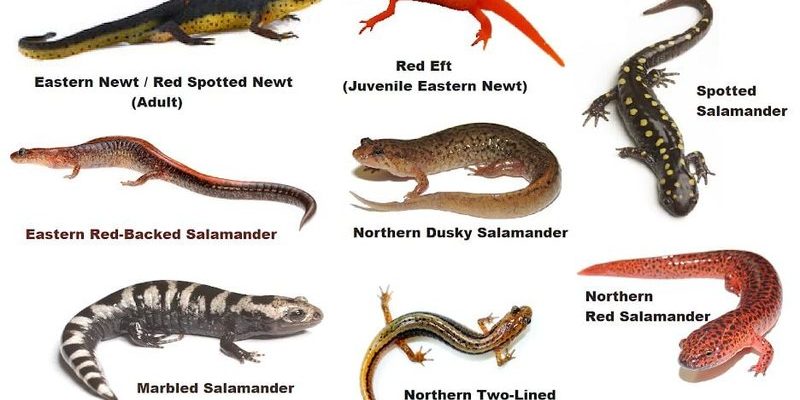![Salamander Vs. [Similar Species] - How They Compare](https://gudri.com/wp-content/uploads/2025/06/Salamander_Vs___Similar_Species____How_They_Compare_image_0.jpg)
You might be wondering why these two species are often grouped together. After all, they both belong to the same order called Caudata, which is a fancy way of saying they have tails. But there’s more to the story! Whether it’s their habitats, behaviors, or even their appearances, there’s a rich tapestry of differences and similarities waiting to be explored.
Physical Appearance: How to Tell Them Apart
At first glance, a salamander and a newt might look like twins. They both have long bodies, four limbs, and tails. However, look closely, and you’ll notice some differences. Salamanders generally have a smoother skin texture, which can often be vibrant in color, ranging from bright yellows to deep blacks. In contrast, newts tend to have a rougher skin texture, and their colors can be more subdued, sometimes with a more mottled appearance.
Another key difference lies in their size. Salamanders can be quite large; some species can grow to be over a foot long! Newts, however, are generally smaller, with most species averaging around 4 to 6 inches in length. If you were to encounter one in the wild, you might be taken aback by how much bigger a salamander can be compared to a newt.
Coloration and Patterns
Both salamanders and newts exhibit a range of colors and patterns, but there’s a fun twist. Salamanders often display bright, eye-catching colors, like fiery oranges and vibrant blues—think of them as the fashionistas of the amphibian world. These colors serve as a warning to predators that they might not be the tastiest choice. Newts, on the other hand, are often more muted with spotted patterns. It’s like they prefer to blend into the background instead of making a dramatic entrance.
Habitat: Where Do They Live?
If you ever find yourself on a nature walk near a pond or damp forest, it’s possible you’ll stumble upon both salamanders and newts. However, they have slightly different preferences when it comes to their homes. Salamanders are more versatile and can thrive in various habitats, including forests, wetlands, and even grasslands. They often prefer moist places to keep their skin hydrated.
Newts, while also found in similar environments, have a strong preference for aquatic habitats, especially during their breeding season. They tend to spend a good chunk of their time in water, particularly in ponds and slow-moving streams. When they’re not swimming, you can typically find them on land in cool, damp areas.
Life Cycle: Growing Up in Different Ways
Both salamanders and newts have fascinating life cycles, but there are distinct stages that set them apart. Both start as eggs laid in water, but here’s where it gets interesting. Salamander larvae typically have external gills that make them look like little fish, while newt larvae might also have gills but often transition to a more terrestrial phase sooner.
Once they mature, newts often spend more time in aquatic environments compared to salamanders. As adults, while newts prefer habitats near water, they tend to venture out more than salamanders do. This difference can have a significant impact on their survival and behavior.
Behavior and Temperament: Who’s More Social?
One of the most intriguing aspects of salamanders and newts is their behavior. If you were to watch them interact, you’d find that newts can be a bit more social. During mating seasons, male newts often display vibrant colors and engage in elaborate courtship dances to attract females. Imagine a dance-off in the animal kingdom!
Conversely, salamanders tend to be more solitary creatures. They usually go about their business without too much fuss and don’t engage in such flashy displays. This difference in behavior can be linked to their habitats and lifestyle choices. Salamanders, being more adaptable, often keep to themselves, while newts like to socialize a bit more—especially when love is in the air.
Feeding Habits: What’s on the Menu?
When it comes to food, salamanders and newts are both carnivorous, but their meals can differ slightly. Salamanders enjoy a buffet of insects, worms, and small invertebrates. They’re like little hunters, using their keen sense of smell to find lunch.
Newts, however, have a more varied diet that can also include small fish and tadpoles. Their time spent in water allows them to take advantage of a broader range of aquatic delicacies. You might say that newts have a more gourmet approach to eating compared to the straightforward palate of a salamander.
Conservation Status: Are They at Risk?
Sadly, both salamanders and newts face threats from habitat loss, pollution, and climate change. Many species of salamanders, particularly in North America, are at risk due to habitat destruction and the introduction of invasive species. It’s a serious issue, and conservation efforts are crucial to protect these creatures.
Newts aren’t immune to these threats either. Some species are endangered due to similar environmental challenges. It’s essential to raise awareness about these issues and support conservation programs that help maintain healthy ecosystems.
How You Can Help
Getting involved in local conservation efforts is a great way to support these amphibians. Simple actions like keeping natural habitats clean, avoiding chemical pesticides in gardens, and participating in local wildlife programs can make a significant difference.
So, whether you’re more drawn to the striking appearance of a salamander or the charming, social nature of a newt, both offer a glimpse into the wonders of our natural world. They may belong to the same family, but they dance to different tunes, each adding its own flavor to the ecosystem.
By taking the time to appreciate their differences and similarities, we can foster a deeper connection to these fascinating creatures. Whether you’re in the woods or just dreaming about a future hike, keep an eye out—you never know when you might spot one of these marvelous amphibians!

